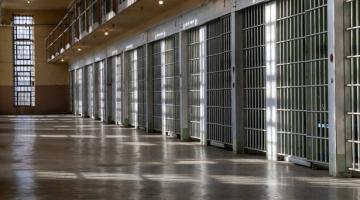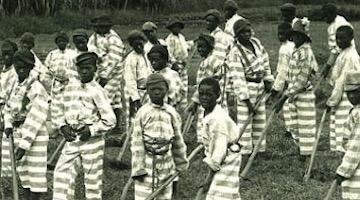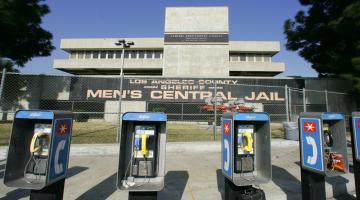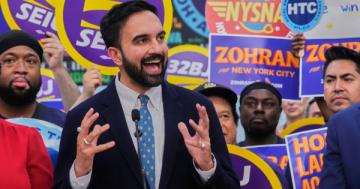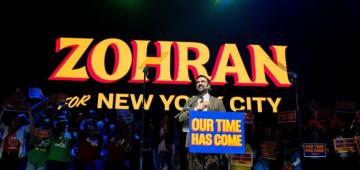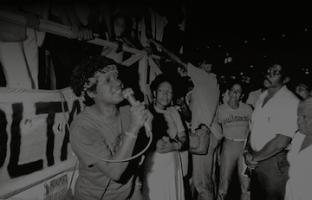Mass Black incarceration didn’t just happen; it was engineered at the highest levels of US government.
“Between the late 1960s and early 1980s, the federal government slowly built a trap, creating the conditions for the mass incarceration of black youth.”
From the War on Poverty to the War on Crime: The Making of Mass Incarceration in America
Elizabeth Hinton
Harvard University Press, $29.95 (cloth)
Elizabeth Hinton’s richly researched new book barrels toward one chilling conclusion: beginning as early as the Johnson administration, federal authorities—regardless of political affiliation—systematically constructed a criminal justice regime that targets, criminalizes, polices, and imprisons staggering numbers of young black men, especially in urban areas.
Some readers might wonder whether the history of mass incarceration could really be so unyielding; historians rarely write with so much conviction about change over time anymore. But Hinton’s documentation is thorough and compelling. As the chapters unfold, she makes clear that, between the late 1960s and early 1980s, the federal government slowly built a trap, creating the conditions for the mass incarceration of black youth with which are now so familiar.
Many will be quick to note that Hinton’s conclusion is not a new one. Michelle Alexander, for example, has already detailed how the architecture of the U.S. criminal justice system bears down on young African Americans, especially in urban centers. As another reviewer has written, Hinton’s book often reads like the prehistory to Alexander’s The New Jim Crow, excavating how contemporary patterns of incarceration originated in the 1960s. And like Naomi Murakawa, author of The First Civil Right: How Liberals Built Prison America (2014), Hinton dispels myths of mass incarceration as a strictly conservative agenda, demonstrating how liberals too have invested in punitive social policies.Still, Hinton’s book is a revelation and a must-read for the depths of evidence it marshals to document the persistent and active role the federal government plays in the rise of mass incarceration.
“Hinton demonstrates how liberals too have invested in punitive social policies.”
According to Hinton, every president since Lyndon B. Johnson has advanced laws, programs, and policies that incentivized aggressive policing in cities with large black communities.And to confine the staggering number of black youth being arrested in Detroit, Los Angeles, and elsewhere, the federal government subsidized the expansion of the nation’s prison system. By the time Ronald Reagan entered the White House, the administrations of Johnson, Nixon, Ford, and Carter had already paved the road to mass incarceration in the United States. Reagan’s War on Drugs only fulfilled earlier plans and prophecies to build a massive prison system and fill it with young black men.
Hinton dispels the myth that mass incarceration is a strictly conservative agenda.
In Hinton’s telling, the history of mass incarceration begins in the 1960s when a fundamental and bipartisan fear “about urban disorder and about the behavior of young people, particularly young African Americans,” gripped the nation. Scholars stoked these fears by describing “unemployed and frustrated Negro youth in congested areas of a city” as the “social dynamite” of American cities. The dynamite exploded when a series of conflicts with law enforcement officers ignited fiery uprisings in Harlem and South Central Los Angeles in July 1964 and August 1965. Johnson interpreted the uprisings as nothing more than explosions of collective violence and crime and believed that only a nationally coordinated War on Crime could stop the infernos. He urged congress to pass the 1965 Law Enforcement Assistance Act, which began to funnel federal dollars into local law enforcement agencies. The capstone of Johnson’s federal law enforcement innovations was the passage of the 1968 Safe Streets Act, which established the Law Enforcement Assistance Administration (LEAA) to coordinate and subsidize dramatic changes in U.S. law enforcement. The LEAA is at the center of Hinton’s argument. By 1977, it had “funneled a total of nearly $6 billion ($25 billion in today’s dollars)” into new law enforcement initiatives. Much of this money was spent on innovating police practices in cities with large black communities and expanding the nation’s jail and prison system.
“Every president since Lyndon B. Johnson has advanced laws, programs, and policies that incentivized aggressive policing in cities with large black communities.”
Politicians were not the only ones to deploy the rhetoric of fear; scholars and fact-finding commissions also supported the LEAA’s focus on urban black communities. On this point, Hinton details the influence of James Q. Wilson and his mentor, Edward C. Banfield, a “gadfly” in urban studies and criminology circles. The two published studies describing urban black neighborhoods as hubs of crime. At a time when Johnson was also pushing a War on Poverty, their work set a particularly punitive tone for federal investment in impoverished urban black communities. But Hinton also takes us into the 1965 fact-finding commission directly responsible for setting LEAA priorities. The commission began its first meeting by hearing from FBI director J. Edgar Hoover, who urged the commission to “dig into” urban black communities, which he believed to be “on the brink of rioting.” Following Hoover’s lead, the commission conducted a study of crime in America but largely limited their data collection and analysis to crime in urban black communities. When the results were tallied, the commission found that crime mostly occurred in black urban communities. “Even though [commission] members were conscious of the shortcomings of the data,” Hinton writes, “they went ahead with the flawed statistics they had to work with in order to deliver a blueprint for the War on Crime.” In turn, the money followed the commission’s diagnosis, flooding black urban communities with law-enforcement dollars.
“FBI director J. Edgar Hoover urged the commission to ‘dig into’ urban black communities, which he believed to be ‘on the brink of rioting.’”
As Hinton explains, one of the first but most enduring changes was to establish new pathways of collaboration between community-based organizations and the criminal justice system. The Department of Justice, for example, offered federal funding to community-based organizations that agreed to label the youth they served as “pre-delinquent” and wrote plans to share space, clients, and information with local police and courts. These funding principles, Hinton writes, created a “middle ground between law enforcement and social services establish[ing] channels of supervision in low-income neighborhoods.” By the early 1970s, around 170 teen centers nationwide had received federal funding for labeling and servicing youth as “pre-delinquent.” The typical participant was a black teen who had “not had contact with the formal justice system” but who, by taking advantage of their neighborhoods’ social services, became the subject of informal surveillance by police and courts. Some leaders within the criminal justice community warned, “Inherent in the process of seeking to identify potential delinquents are certain serious risks—most notably that of a self-fulfilling prophecy.” But the practice endured, and, in time, federal funding priorities entrenched punitive habits within almost every corner of the social welfare system.
The LEAA also allocated millions of dollars to street patrols in targeted cities, namely those with large black communities. One way this was done was through the LEAA’s High Impact program, which systematically defined cities with large black communities—including Baltimore, Newark, St. Louis, Cleveland, New York, Detroit, and Los Angeles—as targets for supplemental, discretionary funding. The funding placed more officers on the beat, supported questionable new tactics, such as sting operations, S.W.A.T. teams, and decoy squads, and allowed police forces to purchase military-grade equipment. All this pushed up arrests. The rising arrest rate was then cited as evidence of rampant crime in urban black communities, precipitating in turn more subsidies for more officers to be sent to such communities. From California to Texas to New York, few cities with large black communities escaped this feedback loop of federal funding, local policing, and black arrests, which made law-enforcement officers omnipresent in segregated urban communities and subjected residents to constant surveillance and police violence in their everyday lives.
“The LEAA’s High Impact program systematically defined cities with large black communities as targets for supplemental, discretionary funding.”
One of Hinton’s most shocking revelations is that even before the street patrols and surge of arrests began, the Nixon administration had made plans to expand the nation’s capacity to imprison black youth. In 1970, when the nation’s imprisoned population was shrinking, Nixon charged the federal Bureau of Prisons with developing a “Long Range Master Plan” to modernize and expand the federal penal system. Forecasting that the nation’s imprisoned population would soon swell because census data showed that black youth were a rapidly growing demographic, the Bureau of Prisons planned to build more than two dozens federal prisons and jails across the country. By 1977, it had opened fifteen new federal prisons, and blacks and Latinos occupied every new prison bed. Nixon also encouraged states to follow the federal government’s lead by pressing Congress to pass the 1970 Crime Control Act, which provided block grants and discretionary funds for states to also expand their prison systems. By late 1976, nearly $3 billion had been dispensed and 430 new jails and prisons had been built across the country. Again, Hinton shows, blacks and Latinos filled most of the new prison cells and jail beds.
Urban public housing facilities were turned into gateways to the U.S. prison system.
Jimmy Carter entered office wary of LEAA. There had been many confirmed reports of poor oversight, fraud, and abuse within the agency. Carter successfully lobbied Congress to break apart the LEAA by passing the Justice System Improvement Act (1979), which split the LEAA into three smaller and more streamlined offices, but he did not end the pattern of massive federal investment in local law enforcement. Instead he channeled federal law enforcement funding into public housing facilities. According to Hinton, new legislation supported by the Carter administration, such as the Public Housing Security Demonstration Act of 1978, as well as the Department of Housing and Urban Development’s Urban Initiatives Anti-Crime program, provided millions of dollars for public housing authorities to install surveillance cameras, lighting, fencing, metal bars, sub-stations, and patrol units in public housing facilities. The idea was to enhance security for public housing residents by flooding “every elevator, walkways and courtyard” with the architecture, design, and authority of law enforcement. It didn’t work. Community safety was not improved, but these tactics did make urban public housing facilities gateways to the U.S. prison system.
“Carter channeled federal law enforcement funding into public housing facilities.”
By the time Reagan was elected, both Democratic and Republican administrations had already prophesized, planned, incentivized, and subsidized a growing prison system and filled it with young black men. Reagan’s War on Drugs, Hinton makes clear, only fulfilled a deeper history born of a “bipartisan consensus of policymakers fixated on the policing of urban space and eventually removing generations of young men and women of color from their communities to live inside prisons.”
That the federal government planned for the mass incarceration of young black men at the close of the twentieth century is the unnerving punch line of Hinton’s work. Was it a conspiracy? No. Hinton stops short of making any such claim. Rather, she documents how diverse federal authorities consistently advanced a set of laws, policies, programs, and practices that pressed toward the same ending: “remov[ing] an entire generation of young men of color from their communities.” Her work leaves little room to doubt that the federal government played a leading role in making mass incarceration a national phenomenon and that the objective of mass incarceration was to criminalize and cage young black men.
Hinton’s focus on the federal government suggests that there is more to be extracted from the archives. The LEAA, for example, did not mark the government’s first foray into law enforcement. As early as 1879 it began subsidizing police forces on Indian reservations, and throughout the following decade, it forcefully asserted authority over immigration matters. Both these realms of federal law enforcement ballooned in the second half of the twentieth century. The LEAA, which noted in 1968 that Native Americans had an arrest rate three times higher than blacks, pumped millions of dollars into policing in Indian Country. Today, Indigenous peoples, whether living on reservations or in cities, are one of the most disproportionately imprisoned populations in the United States. And, of course, the U.S.-Mexico border has emerged as a leading site of arrest and incarceration.
“The federal government played a leading role in making mass incarceration a national phenomenon.”
Hinton notes the importance of immigration control in the late twentieth-century carceral landscape, but she does not investigate it or other arenas of direct and indirect federal law enforcement. In turn, she passes on the opportunity to examine how the federal government’s active role in policing Indigenous communities, borders, and immigrants shaped its investments in patrolling cities, criminalizing young African Americans, and planning the rise of mass incarceration.
To be fair, Hinton never promises to provide such breadth; the product of her focus is the richest historical chronicle written to date of how the War on Crime introduced federal funding and priorities to the policing of urban African American communities. It is a story that anyone concerned about how mass incarceration developed and how we might end it must read.
Kelly Lytle Hernández is Associate Professor of History and Black Studies at UCLA. Her book Migra! explores the untold history of the U.S. Border Patrol.
This article previously appeared in Boston Review.
COMMENTS?
Please join the conversation on Black Agenda Report's Facebook page at http://facebook.com/blackagendareport
Or, you can comment by emailing us at comments@blackagendareport.com

